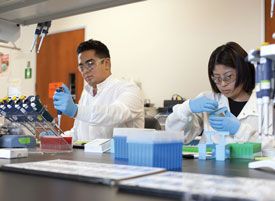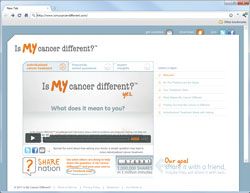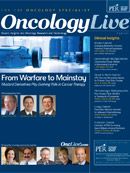Internet Site Helps Oncologists Bridge Patients' Knowledge Gap: An Interview with April Latrice Speed, MD
As cancer treatments become more personalized, patients will be faced with learning complex biological concepts if they want to understand their tumors -- and their choices.

April Latrice Speed, MD, breast specialist, DeKalb Medical Hillandale
As cancer treatments become more personalized, patients will be faced with learning complex biological concepts if they want to understand their tumors—and their choices— at a time when they also are grappling emotionally with the diagnosis of a life-threatening disease.
In September, Clarient, Inc launched IsMyCancerDifferent.com, an Internet site designed to help patients with cancer understand the basics of molecular tumor testing. Clarient, a GE Healthcare company, offers a broad range of cancer diagnostic tests for a variety of tumor types.
Although the site is patient-focused, members of the oncology treatment team may fi nd it is a useful resource for helping them communicate with patients about therapeutic options.
The site includes short videos with cancer survivors and Clarient experts discussing such topics as the basics of tumor biology, methods for testing tumor samples, and ways in which such knowledge is used to choose targeted therapies. Particular tests, however, are not discussed in detail; patients instead are reminded to ask their oncologists about molecular testing.
April Latrice Speed, MD, a breast specialist at DeKalb Medical Hillandale in Lithonia, Georgia, has become an advocate for the site. She was not involved in its creation but has become a supporter of it because it helps her tackle patient communication issues she confronts daily in her practice.
Speed, who received the Diversity in Oncology Initiative award from the American Society of Clinical Oncology last year, discusses the site in this interview.
How do you explain to patients, who often have no medical background or scientific training, about the complex options they face?
It can be very challenging to do that, and I think that’s one of the reasons why IsMyCancerDifferent.com is so important because it does reinforce what I do share with them.
I first start out with the basics, so we go over normal anatomy. Such as, what is normal in all of our breasts? What does a normal breast look like? Then I say, “Well, let’s take a look at your mammogram and let’s see how this is different from the norm.” And so I’ll share with them their images and discuss with them their biopsy results and what needs to be done to address whatever breast issue they may have.
Then I go into the treatment plan, which can be very overwhelming. But I reassure them that it’s very patient-specific and it would be a plan that’s based on their particular tumor, their type of tumor, and that this will determine if they need chemotherapy or if they need additional therapy.
It used to be everyone received the same treatment if they were diagnosed with breast cancer—the same surgery, the same chemotherapy, the same radiation as your mom, as your neighbor, as your friend. But I explain that now we can evaluate your tumor and look at tumor biology, the behavior of your tumor.
How do you use IsMyCancerDifferent.com in these discussions?
When I discuss with them these sorts of very specific details, I can then refer them to the Website, which they can visit at their own leisure. The site explains why it’s important to treat a cancer based on individualized treatment. It really goes into why no 2 patients are the same.
Nothing is more comforting than being able to sit in your pajamas at home and look at a Website that goes over most of what your physician talked about with you in the office.
When they’re here, all they hear is cancer. They don’t hear a treatment plan. They don’t hear about chemotherapy, radiation. All they hear is cancer and so it’s very difficult for them to process. But the Website is less intimidating, it’s reinforcing, and they can do it in the comfort of their own home.

Laboratory specialists at Clarient, a GE Healthcare company, which offers nearly 400 cancer diagnostic tests.
How do you feel this site differs from other oncology information sites?
It’s very patient-friendly. Many of the Websites that we have out are physician-driven and have a very heavy physician presence. This Website puts the patient in the driver’s seat so that they are allowed to initiate the questions once they go back to their doctor, to the medical oncologist, to the radiation oncologist. It empowers them to know what questions to ask, and they’re driving the conversation versus sitting in front of a physician behind a scary desk who says, “Hey, you have cancer and this is your treatment.”
The site does not seem to explore in any detail the tests that are available to characterize a patient’s tumor. Is this a disadvantage?
I think the intent is to get people generally familiar because there are so many tests that are out there. It could be so overwhelming. Even as clinicians, oftentimes we’re torn with what test to order. So, for the patient, you just want them to be aware that there’s additional testing out there and to ask for it.
Most oncologists do personalize medicine. They do send the tissue for those additional tests, but many patients aren’t aware of what that means for them. So the Website can not only educate them that the testing is out there, but also inform them about why it’s important and what that means to them in their cancer treatment. I think it serves 2 purposes: to educate and to reinforce.
Does an information resource for the patient help the treating physician?
It allows the oncologist to have an additional tool that patients can use once they leave the oncologist’s office to go back and say, “Oh, that’s what he or she meant when they said this is my treatment plan or this is what they were referring to when they said that they sent my tissue for additional testing to see how my cancer was different. Other patients have experienced this and they got through it and I can get through it as well.”
So it’s reassuring for the patient because there are people on the Website who look like them and sound like them, have gone through what they’ve gone through. And it’s reinforcing because it allows the patient to be able to reiterate many of the key factors that the oncologist may have mentioned in the consultation that they may have forgotten or, quite frankly, just didn’t hear, just didn’t process.
Has technology changed the dynamics of patient consent?
I think the new technology makes it easier because patients don’t have to make the decision themselves. Their tumor decides. When you have individualized or personalized medicine, we not only look at the surface markers, we look inside the tumor to see what the tumor behavior is like.
Of course, treatment decisions are multifactorial. I’m not going to say that we hang our hat just on the genetic profile or the molecular profile of the tumor, but I think it definitely helps to steer the decision in one way or the other. I think it makes complex choices a little bit more clear.

The Internet site, IsMyCancerDifferent.com, offers an overview of molecular testing and encourages patients to ask questions.
How does IsMyCancerDifferent.com fit into the realm of Internet resources available for patients?
I think this is the second generation of a very consumer- or very patient-driven mission. We started with organizations like the Susan Komen Foundation, a very patient-focused organization that catapulted the way we have cancer awareness and the way we raise money for breast cancer.
This site is where science meets social media. They have links to Facebook and Twitter, where patients and their family members can share information.
How are oncologists trained to talk to patients?
There is no formal training in a lot of places. I was fortunate enough to train in a Susan G. Komen-sponsored Multidisciplinary Breast Fellowship at the MD Anderson Cancer Center in Houston in 2008, and as part of that particular fellowship we had sensitivity training and we learned how to communicate. But not everyone has that training, and so it can be very difficult if you are not comfortable with delivering bad news or not-so-ideal news.
I think most people who go into oncology have a certain level of sympathy and empathy, but it is in varying degrees just like in any profession. So it’s just your own personal style. You have to insert that. It is challenging.
Please describe your training in patient communication.
I received comprehensive training and experience in all aspects of cancer care, not just on the surgical side of things but on the volunteer side, on the education side, where I would go out and do community talks. I would go out and engage in the fundraisers and the runs.
So I’m out there. My boots are on the ground with these women versus behind the safety of my desk where I’m just giving them a diagnosis, and then in surgery where I’m removing tumors.
We rotated through all aspects of the patient’s journey. We interned, shadowed, and participated through each part of the process. We were exposed to every discipline of getting the patient from diagnosis to treatment to surveillance, so it is very hands-on, very comprehensive.




